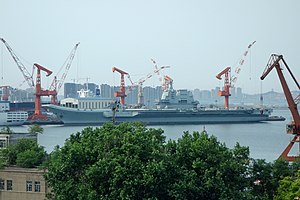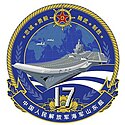Loading AI tools
Chinese aircraft carrier From Wikipedia, the free encyclopedia
Shandong (17; Chinese: 山东舰; pinyin: Shāndōng Jiàn) is a Chinese aircraft carrier that was launched on 26 April 2017 for the People's Liberation Army Navy (PLAN) of the People's Republic of China.[8] It is the country's first domestically built aircraft carrier and second in PLAN service after the completion and commissioning of Liaoning, from which it is derived. Shandong's class was initially suspected to be designated Type 001A[9] (as Liaoning received the designation Type 001) but was revealed to be Type 002 at its commissioning ceremony.[10] The class received the NATO reporting name Kuznetsov Mod. ("modified"), since the design of the ship is a modified version of and similar to the Kuznetsov-class aircraft carrier originally made for the Soviet Navy.[11][12]
 The aircraft carrier Shandong docked at Dalian in 2019 prior to commissioning | |
| Class overview | |
|---|---|
| Builders | Dalian Shipbuilding Industry |
| Operators | |
| Preceded by | Type 001 Liaoning |
| Succeeded by | Type 003 Fujian |
| Completed | 1 |
| History | |
| Name |
|
| Namesake | Shandong province |
| Builder | Dalian Shipbuilding Industry |
| Laid down | March 2013 |
| Launched | 26 April 2017 |
| Completed | 25 April 2018 |
| Commissioned | 17 December 2019 |
| Motto | (Simplified Chinese: 忠诚,勇毅,精武,制胜):Loyalty, Perseverance, Readiness, Victory[1] |
| Status | In active service |
| Badge |  |
| General characteristics | |
| Class and type | Type 002 (variant of Kuznetsov-class aircraft carrier) |
| Type | STOBAR Aircraft carrier |
| Displacement | 60,000 to 70,000 tons, full load[2] |
| Length | 305 m (1,000 ft 8 in)[3] |
| Beam | 75 m (246 ft 1 in)[4] |
| Propulsion | Conventional steam turbines, 4 shafts |
| Speed | 31 knots (57 km/h; 36 mph)[4] |
| Sensors and processing systems |
|
| Armament |
|
| Aircraft carried |
|
Shandong was constructed by the Dalian Shipbuilding Industry, part of the China Shipbuilding Industry Corporation, in Dalian, Liaoning province, China.[13] According to the state Xinhua News Agency, manufacture began in November 2013 and laid down the keel for its hull in a dry dock beginning in March 2015.[13]
The Chinese government did not publicly confirm the ship's existence until construction was well under way. Satellite imagery for the defense analysis industry showed the aircraft carrier in the early stages of hull assembly by March 2015. Public photos of a hull with military characteristics at the Dalian shipyard surfaced on the internet the next month.[14][15] In October 2015, the first definitive signs of the vessel's role appeared when construction of a hangar deck began on the hull.[15] In December 2015, a Chinese defense ministry spokesman confirmed that the ship was an aircraft carrier, stating that the design and construction work was under way.[16]
In May 2016, the ski-jump takeoff ramp was noted to be close to installation.[17] The ship's island superstructure was fabricated in two parts: the nine-deck forward half, containing the bridge and main mast, was installed by September of that year; the aft half, with the funnel and air intakes, was installed in the weeks that followed.[18][19] By the end of 2016, the ship was substantially structurally complete.[20]
Following the launch, the carrier was fitted-out and underwent early tests of the propulsion system.[21] The dockside system trials began after the out-fitting was completed in November 2017.[22]
At the time of its launch, the ship was not expected to be delivered to PLAN until 2020; however, successful early tests put the project ahead of schedule and media reports indicated that it could enter the navy fleet in 2019.[21] While its predecessor CNS Liaoning has been used largely as a training ship since it entered active service in 2012, the Type 002 is expected to be used in regular military operational service.[23]
The first sea trial of the carrier took place in May 2018 in the Bohai Sea.[24] This was followed by eight more trials through November 2019 for a total of about 19 months before the carrier was commissioned. The ninth and final sea trial, which commenced from 14 November 2019, was conducted simultaneously with a training exercise in South China Sea. The dates and durations of the sea trials are as follow:[2]

The arresting gear was installed on 11 September 2018 after the second sea trial. This was immediately followed by flight tests of the J-15, Z-18 and Z-9 on 14 September 2018. J-15D, the electronic warfare (EW) version of the aircraft, was also spotted on deck on 9 October 2018.[2]
The carrier was commissioned on 17 December 2019 at Sanya, Hainan by Central Military Commission chairman Xi Jinping and was officially named Shandong.[25] After commissioning, according to Chinese media Shandong reached in October 2020 initial operating capability (IOC) or basic standards for deployment, which its predecessor Liaoning only attained six years after commissioning, in 2018.[26][27] Lai Yijun, a senior captain who previously commanded PLAN frigate Lianyungang, was the captain of Shandong at commissioning.[25]

During the April 2023 United Sharp Sword military exercises, Shandong was deployed in the Philippine Sea, where it simulated air and sea strikes on neighbouring Taiwan from waters close to Okinawa, according to a report from Japan's Ministry of Defense. Several PLAN jet fighters and helicopters took off and landed on the carrier 120 times in 48 hours.[28] Shandong, three other warships, and a support vessel came to within 230 kilometres of Japan's Miyako Islands at one stage.[29] Taiwan's defence ministry also released a map that showed four Shenyang J-15 fighters flying to the island's east, with the Chinese military later confirming fighters from Shandong, loaded with live ammunition, had "carried out multiple waves of simulated strikes on important targets".[30] Shandong and other vessels accompanying it (one Type 055 destroyer, two Type 052D destroyers, two Type 054A frigates, and a single Type 901 replenishment ship) thereafter sailed east into the Pacific Ocean, at one point coming within 600 kilometers of Guam,[31] before finally turning westwards and entering the South China Sea via the Bashi Channel at the end of April.[32]


The aircraft carrier's external design is largely based on China's first carrier Liaoning, which was itself built from the partially-complete ship of the Soviet Kuznetsov-class aircraft carrier Varyag.[18] It retains the ski-jump takeoff, which limits its air wing to helicopters and Shenyang J-15 fighter jets of the People's Liberation Army Navy Air Force,[17][20] and the ship is powered by conventional oil-fired boilers driving eight steam turbines derived from the Soviet-designed examples installed on Liaoning.[18][33] It measures about 305 metres (1,001 ft) long, with a displacement of about 55,000 metric tons (54,000 long tons) (66,000–70,000 t, 65,000–69,000 long tons loaded).[8][23][3]
While sharing a superficial resemblance to Liaoning, the design details of Shandong are drastically changed and display a higher priority on aircraft operations. The silo space reserved for anti-ship missiles located below the forward flight deck, which was part of the original Kuznetsov design, was removed from the design of Shandong completely, freeing up spaces for additional hangar area. [34] The ski jump angle was optimized from 14.0° to 12.0°, which is the ideal take-off angle for launching the Shenyang J-15 fighter.[34] The island structure is smaller by 10%, and sponsons are extended in the aft-starboard section, allowing more space for up to eight more aircraft and helicopters. A second glaze deck was added to the island, improving flight operation efficiency.[34]
Shandong, like its predecessor, uses the simpler "short take-off barrier-arrested recovery" (STOBAR) launch and recovery system.
Seamless Wikipedia browsing. On steroids.
Every time you click a link to Wikipedia, Wiktionary or Wikiquote in your browser's search results, it will show the modern Wikiwand interface.
Wikiwand extension is a five stars, simple, with minimum permission required to keep your browsing private, safe and transparent.